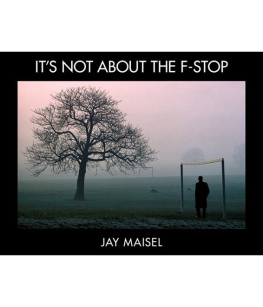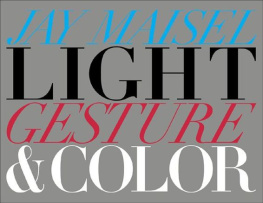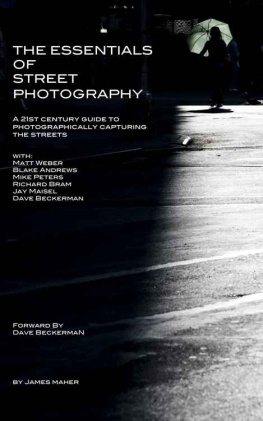ITS NOT
ABOUT THE
F-STOP
JAY MAISEL
Published by New Riders
New Riders is an imprint of Peachpit, a division of Pearson Education.
Copyright 2014 by Kelby Corporate Management, Inc.
All rights reserved. No part of this book may be reproduced or transmitted in any form, by any means, electronic or mechanical, including photocopying, recording, or by any information storage and retrieval system, without written permission from the publisher, except for the inclusion of brief quotations in a review.
Its Not About the f-Stop Book Team
CREATIVE DIRECTOR
Felix Nelson
TECHNICAL EDITORS
Cindy Snyder
Kim Doty
ART DIRECTOR
Jessica Maldonado
ALL PHOTOGRAPHY
Jay Maisel
BACK COVER PHOTO
Stephen Denton
COLOR PRODUCTION SPECIALIST
Marco Ugolini
Trademarks
All terms mentioned in this book that are known to be trademarks or service marks have been appropriately capitalized. New Riders cannot attest to the accuracy of this information. Use of a term in the book should not be regarded as affecting the validity of any trademark or service mark.
Warning and Disclaimer
This book is designed to provide information about photography. Every effort has been made to make this book as complete and as accurate as possible, but no warranty of fitness is implied.
The information is provided on an as-is basis. The author and New Riders shall have neither liability nor responsibility to any person or entity with respect to any loss or damages arising from the information contained in this book.
ISBN 13: 978-0-321-98712-9
ISBN 10: 0-321-98712-8
9 8 7 6 5 4 3 2 1
www.kelbyone.com
www.newriders.com
Contents
This book is dedicated with love to my wife, L.A., and my daughter, Amanda.
About the Author
Born in Brooklyn, New York, in 1931, photographer Jay Maisels career spans 61 years. He studied graphic design with Leon Friend at Abraham Lincoln High School, and painting with Joseph Hirsch in 1949 and Josef Albers in 1953. He informally studied with photographer and graphic designer Herbert Matter in 1952, and had a class with photographer and designer Alexey Brodovitch in 1955. He began working as a freelance photographer in 1954.
Jays name has become synonymous with vibrant color photography that uses light and gesture to create countless unforgettable images for advertising, editorial, and corporate communications. In addition, his pictures appear in books and private, corporate, and museum collections. Some of his commercial accomplishments include five Sports Illustrated Swimsuit Issue covers, the first two covers of New York magazine, and the cover of Miles Davis Kind of Blue. Included among his many awards for excellence are the Art Directors Club Hall of Fame, American Society of Media Photographers Photographer of the Year Award, and the International Center of Photographys Infinity Award.
Since he stopped taking on commercial work in the late 1990s, Jay has continued to focus on his personal work. A graduate of Cooper Union and Yale University, he continues his education by teaching younger photographers at workshops, seminars, and lectures around the world, and has developed a reputation as a giving and inspiring teacher.
Jay married his wife, Linda Adam, in 1989. Their daughter, Amanda, was born in 1993.
Acknowledgements
I want to thank the people who nagged me most to do a book: Hale Gurland, Sam Garcia, Paul Potash, Arthur Meyerson, Stephen Wilkes, Gregory Heisler, and all the others that Ive forgotten.
I also want to thank Felix Nelson, Cindy Snyder, and Jessica Maldonado of KelbyOne, who have been extremely patient with my rantings and ravings about what I did and did not want in the book; and Scott Kelby for being Scott Kelby, which is at times maddening and supportive, if not inspirational.
Lastly, but most valuable, is the help, handholding, and advice that Matt Dean has contributed. Without his patience and administration, this book would still be random images and notes strewn all over The Bank and me screaming, Where the hell did I put everything?
Introduction
Most instructive photographic books tend to dwell a great deal on technique and equipment. This one doesnt.
One of my best friends, Sam Garcia, and I argue endlessly over our differing perceptions of photography. Recently, he said to me, Photography is not about photography, it is about everything else.
I asked, Did you make that up?
He said, Yeah.
I said, I think that is the best thing I have ever heard.
In this book, I tried to talk about everything else.
Be Afraid, Be Very Afraid
Arthur Meyerson, a very good Houston, Texas, photographer, is a buddy of mine. At one point he offered me his studio for an exhibit of my images for FotoFest in Houston. This was an exhibit of 85 images. Another friend of mine, Gary Winter, was doing a video on me. Hes one of these guys who doesnt intrude when hes shootinga real fly on the wall typeso when he asks a question, its a rare occurrence.
So, Jay, he said, Whats the reason you picked these particular 85 pictures for this show?
Theyre my favorites.
I was hoping for something a little more insightful and articulate, he replied.
I thought about it and realized after looking at one particular image what was behind my choices. I explained that when I shot Man with Headband, I was anxious, even terrified, because I knew all the things that could go wrong. It was like a litany: Please dont let the light change, Please dont let somebody walk in front of him, Please dont let him turn around. I realized at that point that each and every picture in the show was a variation of this. A moment charged with all the things that move me, and the fear of losing it. The apprehension, the near certainty that something or someone, if not myself, was going to compromise the image.
There is an emotional seesaw on perceiving what you think is a great image. It moves between glee and trepidation. The more excited I am, the better the image, the more naked emotion I feel, the more exhilaration there is, the more it is counterbalanced by the certainty that something is going to f*% this up.
This anxiety never happens with pictures that are less compelling or less emotional. It never happens with pictures that are intellectually motivated or studies, or with pictures that are about information, history, or pure documentation.
Youre Not Alone
This picture was taken on my first assignment for a national magazine.
I want to set the scene: It was 1954 and I was 23 years old. Marilyn Monroe was at the zenith of her career. Sammy Davis Jr. had come back from having lost an eye and was dancing, singing, and acting his way across the color line and into Americas heart.
My assignment was a simple one: go to an after-party. The event was the premiere of East of Eden with James Dean. Cover the party; come back with pictures of people at the festivities. Make em look good, and kid...dont f*% up.









